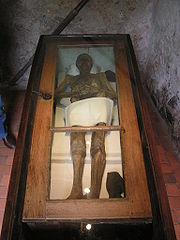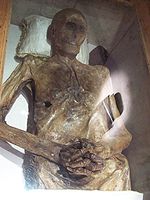
Christian Friedrich von Kahlbutz
Encyclopedia

Brandenburg
Brandenburg is one of the sixteen federal-states of Germany. It lies in the east of the country and is one of the new federal states that were re-created in 1990 upon the reunification of the former West Germany and East Germany. The capital is Potsdam...
– 1702 in Kampehl) was a German
Germany
Germany , officially the Federal Republic of Germany , is a federal parliamentary republic in Europe. The country consists of 16 states while the capital and largest city is Berlin. Germany covers an area of 357,021 km2 and has a largely temperate seasonal climate...
knight
Knight
A knight was a member of a class of lower nobility in the High Middle Ages.By the Late Middle Ages, the rank had become associated with the ideals of chivalry, a code of conduct for the perfect courtly Christian warrior....
, who is today most famous because of the state of preservation of his body; no noticeable mummification
Mummy
A mummy is a body, human or animal, whose skin and organs have been preserved by either intentional or incidental exposure to chemicals, extreme coldness , very low humidity, or lack of air when bodies are submerged in bogs, so that the recovered body will not decay further if kept in cool and dry...
process was used upon his death. Today the mummified corpse is a tourist attraction.
Background
According to local legend, "Knight Kalebuz," as he was known, frequently exercised the right of droit de seigneurDroit de seigneur
Droit du seigneur is an alleged legal right allowing the lord of a medieval estate to take the virginity of his serfs' maiden daughters. There is no historical evidence that such a right ever existed.-Terminology:...
. He had eleven children of his own and at least thirty other illegitimate children. While exercising this "right" in July 1690, he chose the bride of a shepherd from Bückwitz. She refused him and because of the laws governing the right of first night, he murdered the shepherd. Although there were no witnesses, the shepherd's bride, Maria Leppin, accused Kahlbutz of the murder and took him to court in Dreetz
Dreetz
Dreetz is a municipality in the Ostprignitz-Ruppin district, in Brandenburg, Germany....
(Brandenburg). As an aristocrat he had special rights and could swear an oath of innocence before the court in order to free himself. Kahlbutz did this and was immediately acquitted.
Kahlbutz died at the age of 52 and was laid to rest in a double coffin in the family tomb. In 1783 the last of the von Kahlbutz line died. While the church of Kampehl was being renovated in 1794 the coffins in the church were going to be buried in the cemetery like all the other coffins. When the coffins were opened it was discovered that all of the corpses except that of the Knight Kahlbutz had decayed.
Legend
The local populace quickly found an explanation for the Mummy of the Knight of Kahlbutz. They said that it was God's punishment for the murder of the shepherd. It had been said that Kahlbutz had sworn before the court, "It was not I, otherwise after my death my body will not decay".Natural mummification

Rudolf Virchow
Rudolph Carl Virchow was a German doctor, anthropologist, pathologist, prehistorian, biologist and politician, known for his advancement of public health...
and Ferdinand Sauerbruch
Ferdinand Sauerbruch
Ernst Ferdinand Sauerbruch was a German surgeon.Sauerbruch was born in Barmen , Germany. He studied medicine at the Philipps University of Marburg, the University of Greifswald, the Friedrich Schiller University of Jena, and the University of Leipzig, from the last of which he graduated in 1902...
tested the mummy as did Charité
Charité
The Charité - Universitätsmedizin Berlin is the medical school for both the Humboldt University and the Free University of Berlin. After the merger with their fourth campus in 2003, the Charité is one of the largest university hospitals in Europe....
, the largest university hospital in Europe, but all without success. It remains a mystery as to why Kahlbutz's corpse has not decayed, but there are a few other similar cases where the natural decay process has not affected the individual.
The natural decay process of a corpse can be stopped or retarded under certain circumstances, in which the corpse becomes leathery. Air conditions surrounding the body as well as the condition of the ground in which it is buried are most often contributing factors. Absolute dryness, local radioactivity, or other ground factors such as acidity or salts. Also hermetically sealed coffins without steadily moving air can contribute. Likewise, a small ingestion of poisonous medicines, i.e. very small quantities innocuous to an individual, during one's lifetime can aid in the mummification process after death. These kinds of substances are not readily detectable long after death though since the fat and water in the corpse changes and evaporates over time.
Today it is accepted that Kahlbutz suffered from some kind of illness, which caused an emaciation of his body. Possible diseases that he suffered from are cancer
Cancer
Cancer , known medically as a malignant neoplasm, is a large group of different diseases, all involving unregulated cell growth. In cancer, cells divide and grow uncontrollably, forming malignant tumors, and invade nearby parts of the body. The cancer may also spread to more distant parts of the...
, muscular dystrophy
Muscular dystrophy
Muscular dystrophy is a group of muscle diseases that weaken the musculoskeletal system and hamper locomotion. Muscular dystrophies are characterized by progressive skeletal muscle weakness, defects in muscle proteins, and the death of muscle cells and tissue.In the 1860s, descriptions of boys who...
, and tuberculosis
Tuberculosis
Tuberculosis, MTB, or TB is a common, and in many cases lethal, infectious disease caused by various strains of mycobacteria, usually Mycobacterium tuberculosis. Tuberculosis usually attacks the lungs but can also affect other parts of the body...
. There is evidence that he did in fact suffer from the latter. According to several sources, Kahlbutz suffocated on his own blood, which suggests that shortly before his death he lost a great deal of blood. After his death he was buried in an oak double coffin. Bodily decay may have been prevented by the fact that prior to being hermetically sealed in the coffin, he had lost a great deal of blood, in combination with the lack of soil containing decay-accelerating materials.
See also
- IncorruptibilityIncorruptibilityIncorruptibility is a Roman Catholic and Eastern Orthodox belief that supernatural intervention allows some human bodies to avoid the normal process of decomposition after death as a sign of their holiness...
, a property of the bodies of certain saints which, though not mummified, have not decayed
External links
City of KampehlThis article is based on a translation of an article from the German Wikipedia.

